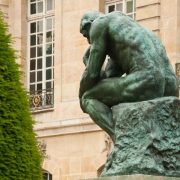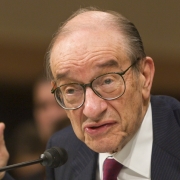Alan Greenspan, as Chairman Of The Federal Reserve Board, unleashed the most destructive spurt of monetary central planning in the history of the world. Now he wants to unleash American entrepreneurship. We have no idea where this recantation came from, but we welcome it. In the following essay, he:
- Recognizes Austrian Economics (the antithesis of his practices at the Fed) in the form of “creative destruction’, the process by which entrepreneurs create betterment for all by continuously improving on their competitors’ efforts.
- Identifies the US as the archetype of Smithian free market economics and the individual pursuit of self-interest for mutual good.
- Highlights the entrepreneurial culture in America, where we create great companies without asking the permission of overlords and bureaucrats.
- Notes perceptively that US is retreating from the dynamism of our past, showing how we are tolerating more industrial concentration, less entrepreneurial dynamism, too much government diverting resources from entrepreneurs to bureaucracies, and the legislative favoring of financialization, empowering a financial sector that is a drain on real entrepreneurial innovation.
His prescriptions are surprising for a central banker, and include:
- Restricting fractional reserve banking from lending each dollar of deposits 10 times to 3 times. It’s still fractional, but would focus credit more on sound investment projects, and divert it away from malinvestments. He’d also put an end to bank bail-outs by the government.
- Limiting government by limiting entitlements. He’d raise the Social Security age and shift government pensions to 401K’s, thus calling for more personal responsibility and less dependency.
He blames government and its policies, not our entrepreneurs, for the loss of dynamism in the economy, and recognizes that the latter, not the former, are the source of the solution. Refreshing.
This article is longer than our normal post, but worth a read.
Four hundred years ago, North America was little more than an empty space on the map—an afterthought in educated minds and a sideshow in European great-power politics. The entire continent produced less wealth than the smallest German principality.
America’s Rise To Economic Greatness.
Today, the United States has the most powerful economy in the world: With less than 5% of the world’s population, it still accounts for almost a quarter of global GDP. America has the world’s highest standard of living apart from a handful of countries with small populations, such as Qatar and Norway. It also dominates the industries that are inventing the future—intelligent robots, driverless cars, life-extending drugs. The fact that 15 of the world’s top 20 universities are based in the U.S. according to the QS World University Ranking, suggests that it is well-placed to dominate the ideas economy.
The rise of the U.S. to economic greatness is an extraordinary story. But it is a story with a sting in the tail. Productivity growth in the U.S. has all but stalled in recent years. The number of new companies being created has reached a modern low. Geographical mobility has been in decline for three decades. Economists worry that America’s potential rate of growth—the pace at which annual output can expand without pushing up inflation—is also falling.
Creative destruction reallocates society’s resources from less productive pursuits to more productive ones.
Why did America become the world’s greatest economy? Why has it lost its momentum in recent years? And what light can history throw on the question of whether the U.S. can be as successful in the future as it was in the past?
The key to America’s success lies in its unique toleration for “creative destruction,” the destabilizing force described by the economist Joseph Schumpeter in 1942. Creative destruction reallocates society’s resources from less productive pursuits to more productive ones—from spinning jennies to factories, for example, or from horse-and-buggies to motorcars.
A range of things, from geography to political culture, have contributed to this enduring preference for change over stability. Consider the sheer size of the U.S., which has allowed it to suck in millions of immigrants and construct continent-spanning companies. It has also allowed the country to shift relatively easily from one industry to another. In Britain, railroads had to make strange loops to avoid ancient settlements. In America, they could carve a straight line from “Nowhere-in-Particular to Nowhere at All,” as the Times of London put it in 1874. The U.S. has sometimes paid a heavy price, both aesthetically and economically, for rapid development, but unlike its European peers, it has avoided chronic stagnation.
There is also the fact that the U.S. was the first country to be born in the modern world of growth and perpetual change. The War of Independence began a year before the publication of the greatest work of free-market economics ever written, Adam Smith’s “The Wealth of Nations” (1776). For most of recorded history, people had inhabited a society that was static and predictable. Smith advanced a vision of society in which the market transformed the pursuit of individual self-interest into the creation of universal progress. Many European countries took generations to come to terms with this insight (some still haven’t). America was born dynamic.
But size and newness are not enough on their own, or else Brazil would be an economic colossus. The U.S. possessed two secret ingredients that turned it into a growth machine.
Culture is key.
The first is its entrepreneurial culture. Americans admire business people in the same way that the English admire gentlemen and the French admire intellectuals. Americans are more inclined to found companies than the people of other countries and are also better at turning small companies into giant ones. The U.S. was the first country to make it easy to create companies without going cap in hand to local bureaucrats who had a right to tell them what to do.
This spirit of entrepreneurship was built into the country’s DNA. The U.S. was founded by settlers who wanted to escape from the restrictions of Europe’s ancient regime: Puritans who wanted to escape from the grip of established churches, younger sons who wanted to escape from the consequences of primogeniture, adventurers who wanted to escape from closed societies.
A striking proportion of America’s entrepreneurial heroes have been immigrants or the children of immigrants. Alexander Graham Bell and Andrew Carnegie were born in Scotland. Andy Grove and Sergey Brin were born, respectively, in Hungary and the Soviet Union.
The U.S. has also benefited enormously from its founding political structure. The Constitution, written in 1787 and ratified in 1788, did its best to constrain the ability of politicians to interfere in the economy. It limits the reach of the federal government by guaranteeing the rights of citizens, not least the right to property, and by dividing power among its branches and with the states. Though governmental powers to tax and regulate have grown enormously over the past century, they remain a world apart from the state control that has long prevailed among America’s chief rivals.
Productivity Was Highest When Government Was Least Active.
The most remarkable period of creative destruction in U.S. history was the era from 1865 to 1900, when government confined itself to providing a stable environment for growth. Titans such as Carnegie and John D. Rockefeller built the world’s biggest and most efficient companies. Railway barons knitted a continent together into the world’s biggest single market.
Though this great revolution was sometimes brutal, it laid the foundations of an era of mass prosperity. Carnegie and Rockefeller reduced the price of steel and oil by almost 90%. R.H. Macy sold “goods suitable for the millionaire at prices in reach of the millions.” Henry Ford trumpeted the Model-T as “a car for the common man.” Their efforts gave Americans a richer diet than their European contemporaries and earlier access to innovations such as electric lights, telephones and cars.
As for the travails of today’s economy, much of it has to do with a retreat from the dynamism of the past. The Economist recently found that more than three-quarters of America’s major economic sectors have seen a decline in competition, with the top handful of firms taking an increasing market share. In 1980, according to the Census Bureau, one in eight companies had been founded in the past year; in 2015 (the last year for good data), the ratio had fallen to fewer than one in 12.
The financial crisis of 2007-2008 showed creative destruction at its worst. The combination of fear and herd behavior led people to overreact to bad news and to plunge economies into self-reinforcing cycles of decline. Nor did the federal government’s heavy-handed regulatory response to the crisis help matters.
Fiscal policy has also hurt the economy. The growth of entitlements such as Social Security and Medicare has crowded out the funding of long-term investment in the private sector and in crucial infrastructure such as roads and airports. Millions of baby boomers are retiring and starting to receive benefits while still quite capable of being productive. In 1965, entitlement spending amounted to 5% of GDP. Today it stands at 14% and is projected to increase still more as the baby boomers retire.
The relative economic stagnation of the past decade has had serious political consequences, breeding discontent and dysfunction in both parties. While President Donald Trump imposes growth-restricting tariffs and bullies errant companies, Democrats embrace ever more interventionist plans to make companies embrace “social purposes.”
The threats now facing the U.S. are bigger than in the past. For the first time in its history, the country confronts, in China, an economic power that is even more populous than itself. But America still has a chance to solve its problems, not least because it continues to have a unique genius for business.
Less Credit Creation, Fewer Entitlements.
The most important item on an agenda for reform is to address the fragility in the American financial system exposed by the financial crisis. Financial institutions play a vital role in allocating society’s savings to fund new ideas and new businesses. Consider how venture capitalists have funded Silicon Valley startups, persuading investors to take long-term risks in return for a stake in a potential breakthrough company.
But too many recent financial innovations have been problematic, not least because they are so sophisticated that even senior bankers don’t fully understand them. They have increased risk by encouraging financiers to package and sell questionable products, such as subprime mortgages. They have also encouraged financiers to become rent-seekers, more interested in serving their own interests than those of the economy as a whole.
In the wake of the crisis, the federal government passed the monstrously complicated Dodd-Frank Act, which tried to reduce risk in the financial system through regulation. A better approach would have been to focus on the amount of capital that banks are required to hold in order to operate. In the run-up to the crisis, banks on average kept about 8 to 10% of their assets as equity capital. If regulators had forced them to keep 25%, or better still 30%, it would have radically reduced the probability of contagious defaults—the root of all financial crises. Today, despite Dodd Frank, they’ve only increased it to a little over 11%.
Such a move would greatly increase overall confidence in the financial system. It would allow lawmakers and regulators to repeal the bank-related provisions in the Dodd-Frank leviathan with a clear conscience because any bank losses would be absorbed by shareholders rather than by taxpayers. It would also allow them to focus their energies where they are best employed, in stamping out fraud.
The usual objection to increasing capital requirements is that it would suppress banks’ earnings and therefore their ability to lend. But a look at history says otherwise. From 1870 to 2017, with rare exceptions, the net income of commercial banks as a percentage of their equity capital fluctuated within a narrow range of 5% to 10% a year, regardless of the size of their capital buffers. This suggests that a gradual rise in banks’ mandated amount of capital would not damage their rate of return or their ability to lend.
A second crucial reform would be to get entitlement spending under control. Putting the system on a more sustainable footing could be done by raising the retirement age by a couple of years, indexing it to life expectancy so that the problem doesn’t keep cropping up—and more importantly, in the longer term, shifting from a system of defined benefits to one of defined contributions, as Sweden accomplished in the 1990s.
Such reforms would assure long-term solvency, release more savings for productive investment and bring down the federal budget deficit. Nor would the reforms impose great suffering on America’s retiring baby boomers. The retirement age was established in 1935, when the system was set up, at a time when life expectancy was much shorter.
America’s problems, in short, are problems of poor policy-making rather than of senescent technology or a lack of entrepreneurial drive. This does not mean that they are insignificant. Unless the U.S. changes course, its economy will continue to flag, holding out the unhappy prospect of a self-reinforcing cycle of low growth and populist rage.
Some economists think that the U.S. is mired in a swamp of low growth. We prefer to think that it is trapped in an iron cage of its own making. Out-of-control entitlements and ill-considered regulations are condemning the economy to perform well below its potential. Swamps by their nature are very difficult to escape. Cages can be opened, provided that you have the right keys—and are willing to turn them.
This essay is adapted from the authors’ new book, “Capitalism in America: A History,” which will be published by Penguin Press on Oct. 16. Mr. Greenspan served as chairman of the Federal Reserve Board from 1987 to 2006. Mr. Wooldridge is the political editor of The Economist. The essay appeared in the October 13, 2018, print edition of The Wall Street Journal as ‘The Great American Growth Machine And How To Fix It Key Reforms to Spark Growth.’













